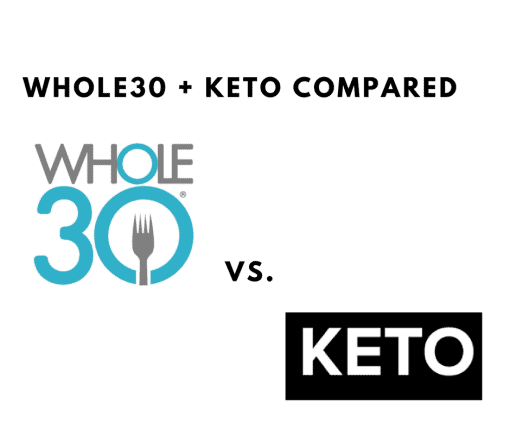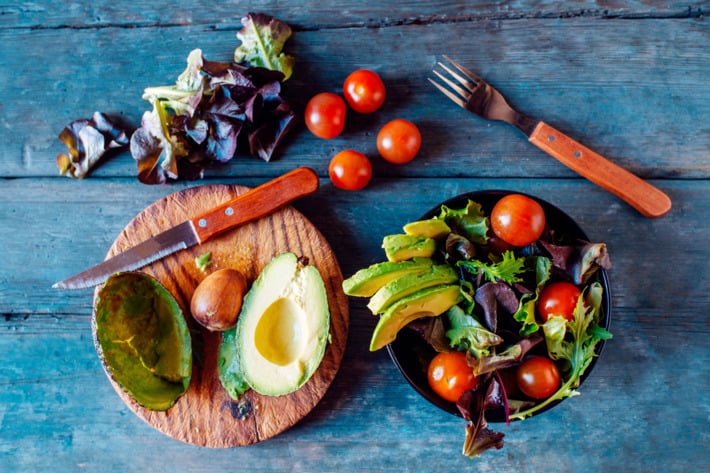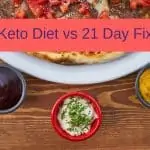At first, dieticians were promoting fat-free eating programs, thinking it was the best solution to achieve one’s desired weight. Well, that’s not the case anymore because diets such as keto and Whole30 are all the rage nowadays.
Topic Contents
Whole30 vs Keto Diet Comparison
There are plenty of other eating plans out there but these two are among the most popular and commonly-tried ones. So, let’s take a closer look at what Whole 30 vs Keto is all about, their pros and cons, similarities, and main differences.
Whole30 vs Keto – Main Differences Summary
Basic Premise
- Whole30 – in this diet, one should eliminate all potentially-inflammatory foods for at least 30 days; this means, you mustn’t eat grains, sugar, legumes, and dairy. As a result, you will get rid of cravings and reset your organism’s good gut bacteria.
- Ketogenic diet – this eating program relies on the process of ketosis in which one’s body consumes fat to obtain energy instead of using carbohydrates. So, simply put, your body will consume fat storage which leads to weight loss. Not only is this a low-carb diet but it is also a high-fat diet.
The Good Part
- Whole30 – you will stop eating processed foods and start consuming simple ingredients. You will not be sugar-dependent anymore and you will have less powerful cravings.
- Ketogenic diet – the process of ketosis provides much more benefits than a simple weight-loss diet. Many dieters have reported an overall improved well-being as well as a boosted brain function.
The Hard Part
- Whole30 – for some people, it is very hard to totally eliminate dairy products. Some simply cannot give up on eating cheese or milk. Also, if you have a cheat moment, you are supposed to return all the way back to Day 1 and start all over again which can be a drawback.
- Ketogenic diet – ketosis is easy to attain but it is quite hard to maintain. Once the ketosis begins, it can be easily ruined or wrecked by carb consumption which is a bit frustrating. If you decide to have a dessert after one meal, it will take several days for your body to bounce back and return on the right track.
Whole30 Overview
Have you heard of the Whole30 diet? If yes, you might have wondered whether or not it is good and beneficial for your body and health. Well, you’ll be pleased to know that you’re not alone. Many people are curious to see how this eating regimen works and what its results are. The program’s creators claim that people who follow this diet plan will experience significant weight loss, improved sleep, and an energy boost. That is one of the few similarities between Whole30 vs Keto diet plans.
What Is the Whole30 Diet?
Contrary to popular belief, Whole30 is truly a weight loss program. This diet was created by Melissa and Dallas Hartwig, and it is a one-month meal plan that will change the way you perceive the process of eating and the foods you include in your daily eating habits. It is said to reset your health and correct harmful or wrong eating behaviors.
What some of you might not like about this diet is the fact that it doesn’t include the concept of “cheating day.” So, in other words, if you do cheat and eat something you shouldn’t, you will be required to start all over again and reset the program back to Day 1. This means you will lose all your progress so you should think twice before indulging in that chocolate dessert you’re craving for.
How Does It Work?
By excluding potentially-harmful foods like packaged and processed products as well as sugar, beans, and dairy, this diet will help you clean your body from toxins and eliminate that extra weight in the process.
Pay attention that this regimen is very restrictive and it is not about cutting down the consumption of certain foods but about eliminating them altogether from your daily diet, for a whole month. This will apparently lead to a healthier metabolism, lowered body inflammation, better-functioning digestive system, and more. It will also curb your cravings and teach you how to carefully choose the food you ingest.
What Foods Are You Allowed to Eat?
You will be allowed to only eat certain whole foods such as the ones listed below:
- Fish – all types of fish, even the canned one as long as you make sure it doesn’t contain a lot of salt;
- Meat – you can have a burger from time to time if you ditch the bread or the bun;
- Poultry – a big YES to eating chicken;
- Fruits – you can eat all kinds of fruits during this diet, especially citric and apples;
- Vegetables – when it comes to veggies, Whole30 diet’s options are simply limitless;
- Healthy fats – you will be able to consume avocados every day.
One surprising thing that you can also consume during the Whole30 period is black coffee. Let’s hope this will make you perceive the program a bit easier.
What You Should Avoid When Following This Eating Regimen
Brace yourself because now it is time for you to find out what foods you will have to eliminate you’re your daily eating habits. You should definitely say NO to these foods:
- Sugar – in all its forms, including both natural and artificial sweeteners; moreover, you cannot eat maple syrup as well;
- Grains – did you think quinoa is good? Well, it might be, but not for this diet;
- Soy – get rid of tofu and other products that contain or are made of soy;
- Legumes and beans – no to chickpeas and a big no to peanut butter;
- Dairy products – you will not be able to consume milk, yogurt, cheese, and any other dairy product;
- Fake treats or snacks – Paleo pancakes, cauliflower crust pizza?! All these are off-limits too;
- Processed additives – sulfites, carrageenan, and others are out of the question.
And, of course, you mustn’t smoke or drink, but that goes without saying.
Pros and Cons of Whole30
Advantages
- This program encourages you to eat whole foods which are completely unprocessed, natural, and healthy;
- During this eating plan, you will learn how to properly read labels and avoid processed foods that have hard-to-pronounce ingredients;
- It is a highly disruptive diet. If you can successfully go through a 30-day period without eating sugars, processed foods, unhealthy fats, and carbohydrates, then, at the end of this program your body will be accustomed to a new and healthier lifestyle;
- It doesn’t require you to count your calories or consider portion control which makes Whole30 a little bit less restrictive;
- It will increase the protein intake which will make you feel fuller for a longer period;
- Many individuals reported a boost in their energy level;
- Provides plenty of anti-inflammatory benefits due to gluten removal.
Disadvantages
- There are several restrictions which make it hard for some people to complete this regimen;
- This diet tends to be low in a couple of minerals and vitamins such as vitamin D and calcium;
- It might be difficult for vegans or vegetarians to follow this program because it totally takes out beans or grains;
- Can be pricey because whole, natural, and healthier foods cost more.
Keto Diet Overview
In order to compare Whole30 vs Keto, we need to understand the keto diet first! The ketogenic diet has gained a lot of popularity in the last couple of years due to the fact that most followers are satisfied with their achieved results. They say it actually works. Moreover, it is backed by more than 20 different studies. Research has shown that the keto plan improves your overall health while also helping you lose weight.
What Is the Ketogenic Diet?
Basically, the ketogenic diet is a restrictive eating program during which you must eliminate carbohydrates and boost the consumption of whole foods and healthy fats (find the best fats to consume on keto here). This will trigger an entire complex process in which the liver will produce ketones that will be used as body energy or fuel. This diet is also known as the low-carb high-fat eating plan.
How Does It Work?
This eating plan works due to the process of ketosis. When you’re following a regular high-carb type of diet, your body receives its needed energy levels from a continuous supply of glucose that travels from one organ to another through the blood. First, carbohydrates are transformed into glucose which then plays the role of a fuel that produces the so-called ATP energy.
By eliminating all carb sources from your diet, the level of blood glucose will go down. This is translated into the appearance of HLS or hormone sensitive lipase which is a fat-burning enzyme. It will release fat from your cells which means that you will eventually lose weight and maintain a slim figure.
What Foods Are You Allowed to Eat?
Here are several examples of keto-friendly foods that you can eat:
- Healthy fats – coconut oil, palm oil, olive oil, seeds, nuts, and even grass-fed butter;
- Non-starchy veggies – cruciferous vegetables like broccoli and others, asparagus, zucchini, leafy greens, cucumber, etc.;
- High-protein foods – pasture-raised chicken, bone broth, grass-fed meats, bio and eco eggs, organ meats, full-fat dairy, wild-caught fish, etc.;
- Fruits – avocado is a great choice that also contains healthy fats; other fruits like berries should be eaten occasionally; (here is a list of fruits and vegetables you should avoid while on keto diet)
- Beverages and condiments – black coffee, plain water, herbal tea, pickles, and fermented foods;
- Nuts and seeds – almonds, macadamia nuts, sesame seeds, hemp seeds (also consumed occasionally).
What You Should Avoid When Following This Eating Regimen
Like any other diet, the keto program also has some foods one should completely avoid:
- Sugars and desserts – juice and other beverages, ice cream, sweetened cereals, candy, white bread, energy bars, etc.;
- Processed foods – no cheese, breakfast cereals, bread, sausages, cakes, biscuits, etc.;
- Carbohydrates – no yams, oatmeal, potatoes, wheat bread, etc.;
- Anything made from grains or regular flour;
- Milk – this is hard to digest and doesn’t contain good gut bacteria;
- Tropical fruits – banana, pineapple, papaya, mango, tangerine; also, you should avoid consuming fruit juices as well as dried fruits like raisins and dates.
Pros and Cons of the Ketogenic Diet
Advantages
- Your body will benefit from reduced levels of insulin;
- Lowers resistance to insulin;
- Increases the fat burning process while also reducing fat storage;
- Improves your overall cognitive functions;
- Curbs cravings and reduces appetite;
- It increases the number of calories your body burns on a daily basis;
- Supports muscle mass growth;
- Lowers the risk of several health conditions, including cancer and neurological diseases;
- It will improve your overall endurance and workout performance.
Disadvantages
- When you start following a keto diet, your organism usually needs around one or two weeks to adjust to this new eating regimen; this adapting period might be slightly uncomfortable;
- It is quite difficult to follow the keto program while attending social events or gatherings because it is hard to find something that complies with this eating plan’s requirements at a restaurant;
- It is a restrictive diet that requires you to completely take out carbs from your meals which some people may not like;
- Athletes or those who perform high-intensity physical activities will not get the necessary amount of energy their body needs in order to perform at its maximum potential.
Whole 30 vs Keto – The Bottom Line
It is true that these two eating regimens have several similarities but they also have some important differences that set them apart. The ketogenic diet focuses on the lack of carbohydrates that will eventually send your body into ketosis while Whole30 will help you find food triggers that make your body feel uncomfortable and bloated.
As you can see, probably the most important difference between these two regimens is represented by carbs. There is even an equation that connects the two diets: you add dairy to the Whole30 meal plan and you take out fruit and carbs to achieve the keto program.
The other two main differences are related to dairy and sugar content. Regarding this aspect, Whole30 is much more flexible and permissive while the keto plan strictly forbids the consumption of carbs, hence no sugars allowed. So, if you cannot stop yourself from eating something sweet now and then, the ketogenic concept might not be for you. However, no matter what diet you choose, you should always do your best in trying to stay away from sugar or at least limit sugar intake as much as possible.
Both these diets are quite restrictive and some people will definitely find hard to follow them in the long-term. Keto and Whole30 require careful meal planning. If someone doesn’t know how to control their food intake and how to properly balance all the vitamins and minerals their body needs, they will lack essential nutrients.
Additional Readings:
- The Best Keto Snack Ideas to Include in Your Ketogenic Diet
- The Best Keto Friendly Restaurant Chains
- Mediterranean Diet vs Keto Diet
- Common Mistakes to Avoid on the Keto Diet That Will Keep the Weight Loss Coming
- The Best Vitamins to Take on the Ketogenic Diet
- Whole30 vs Keto Compared
- 5 Best Ketogenic Diet Books in 2018
Alt Protein Team is a team of professionals and enthusiasts committed to bringing you the most up-to-date information on alternative protein, health and wellness, workouts, and all things health-related. We’ve reviewed a lot of products and services so you don’t have to guess when you spend your hard-earned money on them. Whether you want to shed some pounds, build lean muscle or bulk, we can help you figure out what you need to do and what you need to have to achieve your goals.













